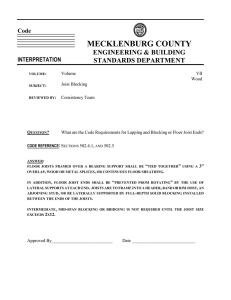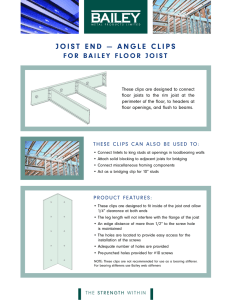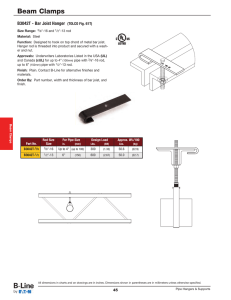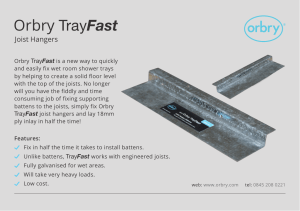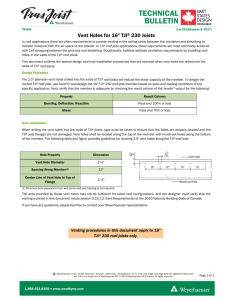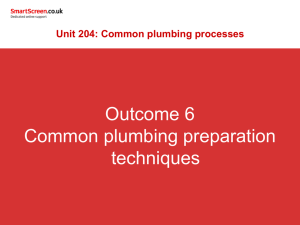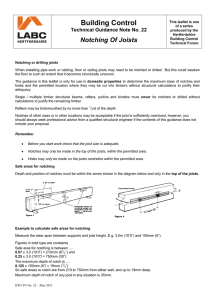Trus Joist Framer`s Pocket Guide
advertisement
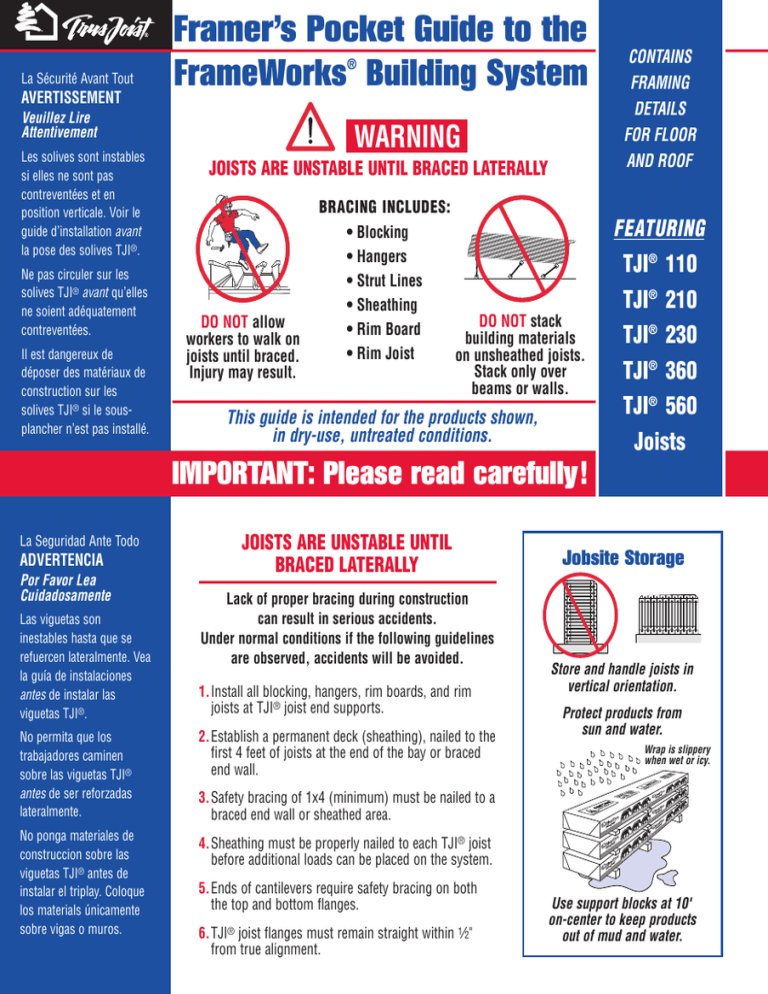
Framer’s Pocket Guide to the FrameWorks Building System ® La Sécurité Avant Tout AVERTISSEMENT Veuillez Lire Attentivement Les solives sont instables si elles ne sont pas contreventées et en position verticale. Voir le guide d’installation avant la pose des solives TJI®. Ne pas circuler sur les solives TJI® avant qu’elles ne soient adéquatement contreventées. Il est dangereux de déposer des matériaux de construction sur les solives TJI® si le sousplancher n’est pas installé. WARNING JOISTS ARE UNSTABLE UNTIL BRACED LATERALLY DO NOT allow workers to walk on joists until braced. Injury may result. BRACING INCLUDES: • Blocking • Hangers • Strut Lines • Sheathing DO NOT stack • Rim Board building materials • Rim Joist on unsheathed joists. Stack only over beams or walls. This guide is intended for the products shown, in dry-use, untreated conditions. CONTAINS FRAMING DETAILS FOR FLOOR AND ROOF FEATURING TJI® 110 TJI® 210 TJI® 230 TJI® 360 TJI® 560 Joists IMPORTANT: Please read carefully ! JOISTS ARE UNSTABLE UNTIL BRACED LATERALLY La Seguridad Ante Todo ADVERTENCIA Por Favor Lea Cuidadosamente Las viguetas son inestables hasta que se refuercen lateralmente. Vea la guía de instalaciones antes de instalar las viguetas TJI®. Jobsite Storage Lack of proper bracing during construction can result in serious accidents. Under normal conditions if the following guidelines are observed, accidents will be avoided. 1.Install all blocking, hangers, rim boards, and rim joists at TJI® joist end supports. No permita que los trabajadores caminen sobre las viguetas TJI® antes de ser reforzadas lateralmente. 2.Establish a permanent deck (sheathing), nailed to the first 4 feet of joists at the end of the bay or braced end wall. No ponga materiales de construccion sobre las viguetas TJI® antes de instalar el triplay. Coloque los materials únicamente sobre vigas o muros. 4.Sheathing must be properly nailed to each TJI® joist before additional loads can be placed on the system. Store and handle joists in vertical orientation. Protect products from sun and water. Wrap is slippery when wet or icy. 3.Safety bracing of 1x4 (minimum) must be nailed to a braced end wall or sheathed area. 5.Ends of cantilevers require safety bracing on both the top and bottom flanges. 6.TJI® joist flanges must remain straight within from true alignment. 1⁄2" Use support blocks at 10' on-center to keep products out of mud and water. 1 Contents FLOOR ROOF & WALL BEAM & COLUMN Allowable Holes — TJI® Joists . . . . . . . . . . . . . . . . . 1 TJI® Joist Nailing Requirements at Bearing . . . . . . . . . . . . . . . . . . 2 FrameWorks® Floor . . . . . . . . . . . 2 Silent Floor® Joist Framing . . . . . . 3 Fastening of Floor Panels . . . . . . . 3 Rim Board Details and Installation . 4 Floor Details . . . . . . . . . . . . . . 4–5 Cantilever Details . . . . . . . . . . . . 5 Filler and Backer Blocks . . . . . . . . 5 Web Stiffeners. . . . . . . . . . . . . . . 6 Framing Connectors . . . . . . . . . . . 8 Allowable Holes — TimberStrand® LSL Wall Studs . . . 2 Web Stiffeners. . . . . . . . . . . . . . . 6 Typical Roof and Wall Framing . . . 6 Ceiling Joists. . . . . . . . . . . . . . . . 6 Roof Details . . . . . . . . . . . . . . . . 7 Birdsmouth Cut . . . . . . . . . . . . . . 7 Framing Connectors . . . . . . . . . . . 8 Shear Blocking and Ventilation Holes . . . . . . . . . . . . . 8 TJI® Joist Nailing Requirements at Bearing . . . . . . . . . . . . . . . . . . 8 Allowable Holes — TimberStrand® LSL, Parallam® PSL, Microllam® LVL Beams and Headers . . . . . . . . . . . 2 Beam and Column Details . . . . . . . 9 Beam and Header Bearings . . . . . . 9 BUILD SAFELY We at Trus Joist are committed to working safely and want to remind you to do the same. We encourage you to follow the recommendations of OSHA (www.osha.gov) in the U.S. or provincial regulations (www.canoshweb.org/en/) in Canada regarding: • Personal protective equipment (PPE) for hands, feet, head, and eyes • Fall protection • Use of pneumatic nailers and other hand tools • Forklift safety Please adhere to the Trus Joist product installation details, including the installation of safety bracing on unsheathed floors and roofs. Product Identification 21⁄16" 13⁄4" 13⁄8" 13⁄8" 91⁄2" 117⁄8" 14" 3⁄8" TJI® 110 joists 25⁄16" 13⁄8" 3⁄8" 91⁄2" 117⁄8" 14" 16" TJI® 210 joists L1 2 x D1 D1 minimum No field cut holes (applies to all in hatched holes except knockouts) zone 117⁄8" 14" 16" TJI® 360 joists 7⁄16" 117⁄8" 14" 16" TJI® 560 joists Does not apply to vented 16" joists 11⁄2" hole may be cut Min. distance from Table B anywhere in web outside hatched zone Do not cut holes larger than 11/2" in cantilever 6" 6" 13⁄8" 3⁄8" TJI® 230 joists Allowable Holes – TJI ® Joists Min. distance from Table A 13⁄8" 91⁄2" 117⁄8" 14" 16" 3⁄8" 31⁄2" 25⁄16" DO NOT cut holes in cantilever reinforcement. 6" L2 2 x L2 minimum D2 6" No field cut holes in hatched zone 6" DO NOT cut or notch flange. Table A —End Support Minimum distance from edge of hole to inside face of nearest end support Joist Depth 91⁄2" 117⁄8" 14" 16" TJI® 110 210 230 360 110 210 230 360 560 110 210 230 360 560 210 230 360 560 Round Hole Size 4" 61⁄2" 87⁄8" 2" 3" 1'-0" 1'-6" 2'-0" 1'-0" 1'-6" 1'-0" 2'-0" 1'-6" 11" 13" Square or Rectangular Hole Size 4" 61⁄2" 87⁄8" 11" 2" 3" 5'-0" 1'-0" 1'-6" 2'-6" 4'-6" 13" 2'-0" 5'-0" 1'-0" 2'-0" 2'-6" 5'-0" 2'-6" 5'-6" 1'-0" 2'-0" 3'-0" 5'-0" 2'-0" 3'-0" 6'-0" 1'-6" 2'-6" 3'-6" 5'-6" 1'-0" 1'-0" 1'-0" 2'-6" 5'-0" 1'-0" 1'-0" 1'-6" 4'-6" 6'-0" 1'-0" 1'-0" 1'-0" 2'-6" 5'-6" 1'-0" 1'-0" 2'-0" 5'-0" 6'-6" 1'-0" 1'-0" 1'-0" 3'-0" 6'-0" 1'-0" 1'-0" 2'-0" 5'-6" 7'-0" 1'-0" 1'-0" 1'-6" 4'-6" 7'-0" 1'-0" 1'-0" 2'-6" 6'-6" 7'-6" 1'-0" 1'-0" 1'-6" 5'-0" 8'-0" 1'-0" 2'-0" 3'-6" 7'-0" 8'-0" 1'-0" 1'-0" 1'-0" 1'-0" 2'-6" 5'-0" 1'-0" 1'-0" 1'-0" 3'-6" 6'-0" 8'-0" 1'-0" 1'-0" 1'-0" 1'-0" 3'-0" 6'-0" 1'-0" 1'-0" 1'-0" 4'-0" 6'-6" 8'-6" 1'-0" 1'-0" 1'-0" 1'-6" 3'-6" 6'-6" 1'-0" 1'-0" 1'-0" 4'-0" 7'-0" 9'-0" 1'-0" 1'-0" 1'-0" 2'-6" 5'-6" 8'-0" 1'-0" 1'-0" 1'-0" 5'-6" 8'-0" 9'-6" 1'-0" 1'-0" 1'-0" 2'-6" 6'-0" 9'-0" 1'-0" 1'-0" 1'-6" 6'-6" 9'-0" 10'-0" 1'-0" 1'-0" 1'-0" 1'-0" 1'-6" 3'-6" 6'-0" 1'-0" 1'-0" 1'-0" 2'-6" 6'-6" 8'-0" 10'-6" 1'-0" 1'-0" 1'-0" 1'-0" 2'-0" 4'-0" 6'-6" 1'-0" 1'-0" 1'-0" 3'-0" 7'-0" 9'-0" 11'-0" 1'-0" 1'-0" 1'-0" 1'-0" 3'-0" 6'-0" 9'-0" 1'-0" 1'-0" 1'-0" 4'-0" 9'-0" 10'-0" 11'-6" 1'-0" 1'-0" 1'-0" 1'-0" 3'-0" 6'-6" 10'-0" 1'-0" 1'-0" 1'-0" 5'-0" 10'-0" 11'-0" 12'-0" Table B —Intermediate or Cantilever Support Minimum distance from edge of hole to inside face of nearest intermediate or cantilever support Joist Depth 91⁄2" 117⁄8" 14" 16" TJI® 110 210 230 360 110 210 230 360 560 110 210 230 360 560 210 230 360 560 1⁄8" Round Hole Size 4" 61⁄2" 87⁄8" 2" 3" 1'-6" 2'-6" 3'-0" 2'-0" 2'-6" 2'-6" 3'-0" 3'-0" 11" 13" Square or Rectangular Hole Size 4" 61⁄2" 87⁄8" 11" 2" 3" 7'-6" 1'-6" 2'-6" 3'-6" 6'-6" 13" 3'-6" 7'-6" 2'-0" 3'-0" 4'-0" 7'-0" 4'-0" 8'-0" 2'-6" 3'-0" 4'-6" 7'-6" 4'-0" 5'-6" 9'-0" 3'-0" 4'-6" 5'-6" 8'-0" 1'-0" 1'-0" 1'-6" 4'-0" 8'-0" 1'-0" 1'-6" 2'-6" 6'-6" 9'-0" 1'-0" 1'-0" 2'-0" 4'-6" 9'-0" 1'-0" 2'-0" 3'-0" 7'-6" 10'-0" 1'-0" 2'-0" 2'-6" 5'-0" 9'-6" 1'-0" 2'-6" 3'-6" 8'-0" 10'-0" 2'-0" 3'-0" 4'-0" 7'-0" 11'-0" 2'-0" 3'-6" 5'-0" 9'-6" 11'-0" 1'-6" 3'-0" 4'-6" 8'-0" 12'-0" 3'-0" 4'-6" 6'-0" 10'-6" 12'-0" 1'-0" 1'-0" 1'-0" 2'-0" 4'-6" 8'-0" 1'-0" 1'-0" 1'-0" 5'-0" 9'-0" 12'-0" 1'-0" 1'-0" 1'-0" 2'-6" 5'-0" 9'-0" 1'-0" 1'-0" 2'-0" 6'-0" 10'-0" 12'-6" 1'-0" 1'-0" 1'-0" 3'-0" 5'-6" 10'-0" 1'-0" 1'-0" 2'-6" 6'-0" 10'-6" 13'-0" 1'-0" 1'-0" 2'-0" 5'-6" 8'-6" 12'-6" 1'-0" 2'-0" 4'-0" 9'-0" 12'-0" 14'-0" 1'-0" 1'-0" 1'-6" 5'-6" 9'-6" 13'-6" 1'-0" 3'-0" 5'-0" 10'-0" 13'-6" 15'-0" 1'-0" 1'-0" 1'-0" 1'-0" 3'-0" 5'-6" 9'-6" 1'-0" 1'-0" 1'-0" 4'-6" 9'-6" 12'-6" 15'-6" 1'-0" 1'-0" 1'-0" 1'-6" 4'-0" 6'-6" 10'-6" 1'-0" 1'-0" 1'-0" 5'-0" 10'-6" 13'-0" 16'-0" 1'-0" 1'-0" 1'-0" 3'-0" 6'-6" 10'-0" 13'-6" 1'-0" 1'-0" 2'-0" 7'-6" 13'-0" 14'-6" 17'-0" 1'-0" 1'-0" 1'-0" 2'-6" 7'-0" 11'-0" 15'-0" 1'-0" 1'-0" 3'-6" 9'-0" 14'-6" 16'-0" 18'-0" • Leave web at top and bottom of hole. DO NOT cut joist flanges. • Table is based on uniform load tables in current design literature. • For simple-span (5' minimum), uniformly loaded joists not requiring commercial concentrated loads, one maximum size round hole may be located in the center of the joist span provided no other holes occur in the joist. 2 Allowable Holes – TimberStrand® LSL, Parallam® PSL, Microllam® LVL Beams and Headers 2 x diameter of the largest hole (minimum) 1⁄3 Allowed hole zone 1⁄3 span depth 1⁄3 depth 1⁄3 depth 1⁄3 1⁄3 span Allowed hole zone span Round Hole Chart • • • • For uniformly loaded beams only. Rectangular holes are not allowed. No holes in cantilevers. No holes in headers or beams in plank orientation. Beam Depth Maximum Round Hole Size 43⁄8" 51⁄2" 71⁄4" to 20" 1" 13⁄4" 2" Cut only round holes and only in the center of beam. Allowable Holes – TimberStrand® LSL Wall Studs The notch shown may be cut anywhere except the middle 1/3 of the length of the stud 5⁄8" minimum edge distance Maximum notch: 7⁄8" for 2x4 13⁄8" for 2x6 and 2x8 Maximum diameter: 13⁄8" for 2x4 23⁄16" for 2x6 and 2x8 TJI® Joist Nailing Requirements at Bearing Squash Blocks to TJI® Joist Connections to Bearing Plate (Load bearing wall above) Trus Joist rim board One 10d (3") box nail into each flange One 8d (21⁄2") box nail each side. Drive nails at an angle at least 11⁄2" from end. • 13⁄4" minimum end bearing for single family applications • 21⁄4" minimum end bearing for multi-family applications • 31⁄2" minimum intermediate bearing • 51⁄4" may be required for maximum capacity Also see detail B2, page 5 Shear transfer: Connections equivalent to deck nailing schedule. See page 4. Rim to TJI® Joist Trus Joist rim board or TJI® 110 rim joist: One 10d (3") box nail into each flange TJI® 210, 230, and 360 rim joist: One 16d (31⁄2") box nail into each flange TJI® 560 floor joist TJI® 560 rim joist: Toenail with 10d (3") box nails, one each side of TJI® joist flange Top View TJI® 560 rim joist FrameWorks® Floor System FrameWorks® FLOOR SYSTEM COMPONENTS • TJ®-Performance Plus® floor panels • TJI® joists • Trus Joist rim board Nail to joist at 12" on-center in field and 6" on-center along panel edges. Apply fasteners 3⁄8" from panel edges. • For 3⁄4" panels, use 8d (21⁄2") common or 6d (2") deformedshank nails or other code-approved fasteners. • For 7⁄8" panels, use 8d (21⁄2") common or 8d (21⁄2") deformed-shank nails or other code-approved fasteners. .2" 19 " 24 4" "/2 16 " 16 .2" 19 " 24 Use a 1⁄4" or larger bead of adhesive " 16 ADHESIVE RECOMMENDATIONS • Adhesives must meet the requirements of ASTM D 3498 (AFG-01), and they must have a minimum dry shear strength of 350 psi. For more information, contact your Trus Joist technical representative. 4" "/2 16 At abutting panel edges use two 1⁄4" beads of adhesive • Fully nail floor panel within 10 minutes of applying adhesive or sooner if required by adhesive manufacturer. • Screws may be substituted for nails (above) if they have equivalent lateral load capacity. 3 Silent Floor ® Joist Framing See filler and backer block notes, page 5 Silent Floor® joist framing does not require bridging or mid-span blocking Safety bracing (1x4 minimum) at 6' on-center and extended to a braced end wall. Fasten at each joist with two 8d (21⁄2") nails minimum (see WARNING on cover). Blocking panel Use only engineered lumber for rim board or blocking. E1 H2 E2 Rim board joint between joists A1 TJI® rim joist A3_ CS A2 Trus Joist rim board L3 B1 L1 H1 B2 L5 B3 B4 P Use B1 or B2 at intermediate bearings with load bearing or shear wall from above End of joists at centerline of support H1 WARNING Joists are unstable until laterally braced. See warning on cover. L4 Protect untreated wood from direct contact with concrete Bearing plate to be flush with inside face of wall or beam Structural sheathing H3 See Allowable Holes, page 1 INSTALLATION TIPS • Subfloor adhesive will improve floor performance, but may not be required. • When joists are doubled at non-load bearing parallel partitions, space joists apart the width of the wall for plumbing or HVAC. • Additional joist at plumbing drop (see detail above). Shifted joist LA See Exterior Deck Attachment, page 4 Additional joist Plumbing drop • Squash blocks and blocking panels carry stacked vertical loads (details B1 and B2). Packing out the web of a TJI® joist (with web stiffeners) is not a substitute for squash blocks or blocking panels. DETAIL SCHEDULE End bearings (see page 4) Cantilever over brick ledge (see page 5) A1 with blocking panels E5 3⁄4" reinforcement on one side A2 with TJI® rim joist E6 3⁄4" reinforcement both sides with rim board E7 3⁄4" reinforcement on one side, with 2x_ blocking A3_ Intermediate bearings* (see page 5) E8 3⁄4" reinforcement on both sides, with 2x_ blocking B1 with blocking panels to support load bearing wall above B2 with squash blocks to support load bearing wall above H1 TJI® joist to beam (see page 8) B3 without blocking panels or squash blocks (no wall above) H2 TJI® joist to joist (see page 5) H3 TJI® joist on masonry wall or steel beam (see page 8) Cantilever details (see page 5) E1 no reinforcement Hanger details (more connector information on page 8) Other details cantilever with reinforcement B4 butting joists with blocking panels E2 3⁄4" reinforcement on one side CS column support (see page 4) E3 3⁄4" reinforcement both sides LA exterior deck attachment (see page 4) E1W E4 joist reinforcement W web stiffeners (see page 6) F1 deck cantilever L beam details (see page 9) PB1 permanent cantilever bracing P column details (see page 9) *Load bearing wall must stack over wall below. Blocking panels may be required at shear walls above or below. TJ-Xpert® Framing Plans A_ X At A1, joists require entire support width. At A2, A3 and A3.1–A3.4, “X” is rim board or rim joist thickness. Required joist bearing length = (full support width minus X). B_ W Web stiffeners required on each side of joist at intermediate bearings. Refer to your TJ-Xpert® framing plan. Bearing requirements as shown on the TJ-Xpert® framing plan are job-specific and supersede minimum bearing requirements listed. Fastening of Floor Panels Guidelines for Closest On-Center Spacing per Row Nail Size 8d (21⁄2") common 10d (3") common 16d (31⁄2") common TJI® 110 and 230, 360, 210 and 560 31⁄2" 2" 41⁄2" 3" N.A. 4" Trus Joist rim board 1" 11⁄4" 6" 6" 16" 4" 4" 6"(1) TimberStrand® LSL Microllam® LVL Parallam® PSL 11⁄2" or wider 3" 4" 6"(1) 3" 4" 8" 3" 4" 6" (1) Can be reduced to 4" on-center with maximum nail penetration of 13⁄8" into the narrow edge • Recommended nailing is 12" on-center in field and 6" on-center along sheathing edge. Nailing requirements on engineered drawings supersede recommendations. • Nailing rows must be offset at least 1⁄2" and staggered. • 14 ga. staples may be substituted for 8d (21⁄2") nails if minimum penetration of 1" into the TJI® joist or rim board is achieved. Farthest On-Center Spacing Per Row Maximum spacing of nails is: • 18" on-center for 13⁄4" joist widths. • 24" on-center for joist widths greater than 13⁄4". 4 Rim Board Details and Installation Plate nail Plate nail Remove tongue and groove from floor panel edges supported by 1" e-Rim® to ensure quality nailing* 2x4 or 2x6 stud wall at 16" on-center Deck nail Attach panel per nailing schedule (below) Trus Joist rim board Deck nail A3 A3.1 A3.2 A3.3 TJI® joist spanning in either direction *According to ICBO Evaluation Services, Inc., it is necessary to trim the panel edges when using 11/8" or thinner rim board. Specifications Rim Board Thickness Plate Nail— 16d (31⁄2") box Deck Nail— 8d (21⁄2") common Toe Nail— 10d (3") box Sill Plate Anchor Bolt A3 1" or 11⁄4" 16" o.c. 6" o.c. 6" o.c. 1⁄2" dia. at 6' o.c. Exterior Face Interior Face Wall Framing Intermediate Nailing Max. Wall Opening Height % of Wall with Full Height Sheathing Sheathing Boundary Nailing Intermediate Nailing Hold-Downs (if required) Per code TJI® joist spanning in either direction 12" minimum Install proper blocking to support all panel edges A3.4 A3.1(1) 1" 16" o.c. 6" o.c. 6" o.c. 1⁄2" dia. at 6' o.c. A3.2(1) 11⁄4" 12" o.c. 6" o.c. 6" o.c. 1⁄2" dia. at 6' o.c. Sheathing Boundary Nailing Trus Joist rim board Toe nail Toe nail Sheathing may be attached as shown in A3.4 2x4 or 2x6 stud wall at 16" on-center Per code Per code A3.3(1) 11⁄4" 8" o.c. 6" o.c. 4" o.c. 5⁄8" dia. at 6' o.c. A3.4(1) 11⁄4" 12" o.c. 6" o.c. 6" o.c. 5⁄8" dia. at 4' o.c. 3⁄8" structural 1 sheathing at corners and every 25' o.c. 1⁄2" fiberboard in all other areas(2) 3⁄8" structural 1 sheathing in all areas(3) 8d common at 6" o.c. 8d common at 4" o.c. 8d common at 12" o.c. 5'-4"(4) 8d common at 12" o.c. 5'-4"(4) 70% 1⁄2" Per code Per code Per code Per code 16" o.c. within 10' of corners(5) 16" o.c. within 6' of corners(5) gypsum 5d cooler at 7" o.c. 5d cooler at 10" o.c. 16" o.c. within 4' of corners(5) 70% 1⁄2" gypsum 5d cooler at 7" o.c. 5d cooler at 10" o.c. N.A. (1) All sheathing shall be properly blocked and nailed. (2) Detail A3.3 shall be a segmented wall, constructed per the 1995 SBC Wood Frame Construction Manual. (3) Sheathing shall be continuous over all plate-to-plate and plate-to-rim board interfaces and may butt together at mid-depth of rim board as shown in A3.4. At foundation, fasten the bottom edge of the sheathing to the sill plate. (4) One 6'-8" standard door opening is allowed. (5) If required, hold-downs shall be Simpson Strong-Tie™ CS20 straps attached with four 8d common nails at each end or equivalent. As an alternative to hold-down straps, wall sheathing may be attached as shown in A3.4 (refer to footnote 3). Floor Details Blocking panel TJI® rim joist A1 A2 Must have 13/4" minimum joist bearing at ends Exterior Deck Attachment Load from above Structural exterior sheathing Trus Joist rim board Flashing Treated 2x_ ledger 2x4 minimum squash blocks 1⁄16" squash blocks to transfer CS Use 2x4 minimum ® load around TJI joist Maintain 2" distance (minimum) from edge of ledger to fastener LA Corrosion-resistant fasteners required for wet-service applications 5 Floor Details Load bearing or shear wall above (must stack over wall below) Intermediate Bearing — No Load Bearing Wall Above Blocking panel 2x4 minimum squash blocks B1 B1W Web stiffeners required each side at B3W Blocking panels may be required with shear walls above or below—see detail B1 1⁄16" Web stiffeners required each side at B1W and B2W B2 B2W B3 B3W Cantilever Details Trus Joist rim board closure, typical 8" diameter maximum hole for 117⁄8"–16" deep blocking panels; 6" diameter maximum for blocking panels 91⁄2" deep or shorter than 12" long. Do not cut flanges. 4'-0" length of 3⁄4" reinforcement (2'-0" maximum cantilever) on one side at E2, both sides at E3. Attach to joist with 8d (21⁄2") common nails at 6" on-center. When reinforcing both sides, stagger nails. Web stiffener E1 E1W Trus Joist rim board, typical. Nail with 10d (3") box nails, one each at top and bottom flange. E2 E3 l L/3 ypica t x., a m 8' E4 PB1 um ) xim nly ma ads o " 0 4'- rm lo ifo (un E5 E6 gth len ver e l i t can es tim 1 ⁄2 1 F1 E8 E7 12" length of 3⁄4" reinforcement on one side at E5/E7, both sides at E6/E8. Attach to joist flanges with one 8d (21⁄2") common nail at each corner. Nail through 2x_, wood backer and TJI® joist web with 2 rows 10d (3") common nails at 6" on-center, clinched. Use 16d (31⁄2" nails with TJI® 560 joists. F1 applies to uniformly loaded joists only. Wood backer Less than 5" Blocking panel between each joist. Full depth vertical blocking at E5 and E6, horizontal blocking at E7 and E8. Nail with connections equivalent to decking schedule (E7 and E8) 6'-0" length of TJI® joist reinforcement (2'-0" maximum cantilever) and filler block at E4. Use 4'-0" length with 91⁄2" and 117⁄8" TJI® joists. Attach to joist web with 3 rows 10d (3") common nails at 6" on-center, clinched. Use 2 rows with 91⁄2" and 117⁄8" TJI® joists. Not for use with TJI® 560 joists. Two 21⁄2" screws for 2x_ strapping connections Apply subfloor adhesive to all contact surfaces Two 8d (21⁄2") box nails or 21⁄2 screws, typical PB1 Required only when specified on the layout Filler and Backer Blocks x x x x x x x x x x x xx x HANGER BACKER BLOCK Install tight to top flange (tight to bottom flange with face mount hangers). • Single-Family Applications: Attach with ten 10d (3") box nails, clinched when possible. • Multi-Family Applications: Attach with fifteen 10d (3") box nails, clinched when possible. • If necessary, increase filler and backer block height for face mount hangers and maintain 1⁄8" gap at top of joist; see detail W on page 6. • Filler and backer block dimensions should accommodate required nailing without splitting. HANGER BACKER BLOCK SIZES H2 Backer block both sides of web with single TJI® joist DOUBLE TJI® JOIST FILLER BLOCK • Single-Family Applications: Attach with ten 10d (3") box nails, clinched. Use ten 16d (31⁄2") box nails from each side with TJI® 560 joists. • Multi-Family Applications: Attach with fifteen 10d (3") box nails, clinched. Use fifteen 16d (31⁄2") box nails from each side with TJI® 560 joists. • • • • TJI® 110 joists: 5⁄8", minimum length 12" TJI® 210 joists: 3⁄4", minimum length 12" TJI® 230 and 360 joists: 1" net, minimum length 12" TJI® 560 joists: 2x_, minimum length 12" • • • • TJI® 110 joists: 2x_, minimum length 24" TJI® 210 joists: 2x_ + 3⁄8" sheathing, minimum length 24" TJI® 230 and 360 joists: 2x_ + 1⁄2" sheathing, minimum length 24" TJI® 560 joists: Two 2x_, minimum length 24" DOUBLE TJI® JOIST FILLER SIZES 6 Web Stiffeners – Floor and Roof Applications Gap: 1⁄8" minimum 23⁄4" maximum Three 8d (21⁄2") box nails, clinched (Three 16d (31⁄2") box nails at TJI® 560) 11⁄2" 11⁄2" Web stiffener each side. See sizes below. W Tight fit WEB STIFFENER REQUIREMENTS Required at all birdsmouth cuts. Required at all sloped hangers. For TJI® 560 joists, web stiffeners are required at all hanger locations. Required if the sides of the hanger do not extend to laterally support at least 3/8" of the TJI® joist top flange. WEB STIFFENER SIZES • • • • TJI® 110 joists: 5⁄8" x 25⁄16" minimum TJI® 210 joists: 3⁄4" x 25⁄16" minimum TJI® 230 and 360 joists: 7⁄8" x 25⁄16" minimum TJI® 560 joists: 2x4 Web stiffeners are required when intermediate bearing lengths are less than 5 1/4" except where noted on framing plan. Typical Roof and Wall Framing Bearings (see page 7) DETAIL SCHEDULE Other details R1 on bevel plate O 2x_ overhang at end wall R3 with variable slope seat connector SB shear blocking (see page 8) R5 with birdsmouth cut W web stiffeners R7 intermediate bearing R14 ridge detail Outrigger details (see page 7) R8 2x4 outrigger and filler with birdsmouth cut R9 2x4 outrigger without filler R10 2x4 outrigger and filler Hanger details (see page 8) H5 slope adjusted hanger H6 header on slope Joists must be laterally supported at cantilever and end bearing by blocking panels, hangers, or direct attachment to a rim board or rim joist See filler and backer block notes, page 5 Safety bracing (1x4 minimum) at 6' on-center and extended to a braced end wall. Fasten at each joist with two 8d (21⁄2") nails minimum (see WARNING on cover). H5 R14 H6 R10 2x4 block for soffit support Blocking panels or shear blocking optional for joist stability at intermediate supports R7 R5 R9 O R3 24" max. R1 R1 R10 Install cripples tight to king stud at each end of header WARNING Joists are unstable until laterally braced. See warning on cover. Double joist may be required R8 Ceiling Joists Notch around TJI® joist top flange Let-in bracing Ceiling joist must be braced at 18" on-center Safety bracing. Lack of proper bracing can result in serious accidents. Studs must be doubled when notched in middle third of length. Refer to hole charts for allowable holes and notches. TimberStrand® LSL blocking: • 1 row at 10'–18' height • 2 rows at 18'–22' height Lateral bracing required at end bearings See Allowable Holes, page 1 " 24 um xim a m Do not bevel cut joist beyond inside face of wall 7 Roof Details V-cut shear blocking— Trus Joist rim board Shear blocking—TJI® joist or TimberStrand® LSL rim board Variable slope seat connector Beveled bearing plate required when slope exceeds 1⁄4" per foot 1⁄3 1⁄3 adjacent span maximum R1 adjacent span maximum R3 Intermediate Bearing Blocking panels or shear blocking may be specified for joist stability at intermediate supports Web stiffeners required each side at R7W Twist strap and backer block required at R7S with slopes greater than 3" per foot. See nailing requirements, page 8. 2 rows 8d (21⁄2") box nails at 8" on-center " -0 4' mum ini m 2x4 one side. Use 2x4 both sides if joist spacing is greater than 24" on-center 1⁄8" Filler Filler Beveled bearing plate required when slope exceeds 1⁄4" per foot Beveled 2x4 block 0" 2'- um xim a m R7 R7 W R7 S R10 Beveled bearing plate required when slope exceeds 1⁄4" per foot Birdsmouth Cut — R5, R8, and R9 Allowed at low end of joist only 2 rows 8d (21⁄2") box nails at 8" on-center m 4'-0 in im " um Beveled web stiffeners on both sides. Cut to match roof slope. 2x4 one side. Use 2x4 both sides if joist spacing is greater than 24" on-center 1⁄8" TJI® joist flange must bear fully on plate 0" 2'- um xim ma 2x4 block for soffit support Birdsmouth cut must not overhang inside face of plate R8 m 4'in 0" im um R5 Beveled 2x4 block with beveled web stiffener on opposite side of web 0" 2'- um xim a m 2x4 one side. Use 2x6 if joist spacing is greater than 24" on-center. LSTA18 (Simpson or USP) strap with twelve 10d x 11⁄2" nails 10d (3") box nails at 8" on-center 0" 2'- um im x ma Beveled 2x4 block Double beveled bearing plate when slope exceeds 1⁄4" per foot Beveled web stiffeners on both sides R9 R14 Strap nails: Leave 23⁄8" minimum end distance, typical 8 Framing Connectors APPROVED HANGERS Hanger height must be a minimum of 60% of joist depth • The following three manufacturers are approved to supply hangers for Trus Joist products: – Simpson Strong-Tie™ 1-800-999-5099 – USP Structural Connectors™ 1-800-328-5934 (MN) or – 1-800-227-0470 (CA) – Simpson Strong-Tie™, Canada 1-877-642-2121 • Hanger design loads differ by support type and may exceed the capacity of the support and/or supported member. Contact your Trus Joist representative or refer to Trus Joist software. Top flange hanger Face mount hanger Web stiffeners required if the sides of the hanger do not laterally support at least 3⁄8" of the TJI® joist top flange NAILING REQUIREMENTS • Fill all round holes with the proper nails. Hanger nails are usually a heavier gauge because of the higher loads they need to carry. • Unless specified otherwise, full capacity of straps or connectors can only be achieved if the following nail penetration is provided: H1 Flush bearing plate required. Maximum 1⁄4" overhang permitted at beam. FACE MOUNT TOP FLANGE 10d x 11⁄2" 11⁄2" min 11⁄2" min 3 10d (3") common 1 ⁄4" min 3" min 16d (31⁄2") common 2" min 31⁄2" min • Top flange hangers should be fastened to TJI® joist headers with 10d x 11⁄2" nails. Fasten face mount hangers to 31⁄2" or wider TJI® joist headers with 10d (3") common or 16d (31⁄2") common nails. H3 LSTA24 (Simpson or USP) strap with twelve 10d x 11⁄2" nails required at H5S with slopes greater than 3" per foot CONNECTOR INSTALLATION & SQUEAK PREVENTION TIPS • Nails must be completely set. • Leave 1⁄16" clearance between the member and the support member or hanger. • Joist to beam connections require hangers; do not toenail. • Seat the supported member tight to the bottom of the hanger. On Simpson Strong-Tie™ ITT, IUT and VPA connectors, bend the bottom flange tabs over and nail to TJI® joist bottom flange. • Reduce squeaks by adding subfloor adhesive to the hanger seat. Strap nails: Leave 23⁄8" minimum end distance H5 H5 S Variable slope joist hanger Filler block: Attach with ten 10d (3") box nails, clinched. Use ten 16d (31⁄2") box nails from each side with TJI® 560 joists. Backer block: Install tight to bottom flange (tight to top flange with top flange hangers). Attach with ten 10d (3") box nails, clinched when possible. Strap nails: Leave 23⁄8" minimum end distance, typical H6 H6 S LSTA18 strap required at H6S with slopes greater than 3" per foot Variable slope joist hanger. Beveled web stiffeners required on each side. Shear Blocking and Ventilation Holes Roof Only 1⁄3 Trus Joist rim board for shear blocking (between joists). Field trim to match joist depth at outer edge of wall or locate on wall to match joist depth. 1⁄3 1⁄3 1⁄2 1⁄2 Maximum allowable V-cut SB TJI® Joist Nailing Requirements at Bearing TJI® Joist to Bearing Plate END BEARING (13⁄4" minimum bearing required) 8d (21⁄2") box nail, one each side, 11⁄2" minimum from end Blocking to Bearing Plate INTERMEDIATE BEARING (31⁄2" minimum bearing required) Slopes 3/12 or less: One 8d (21⁄2") box nail each side (see Detail R7) Slopes greater than 3/12: Two 8d (21⁄2") box nails each side, plus a twist strap and backer block (see Detail R7S). When slope exceeds 1⁄4" per foot, a beveled bearing plate, variable slope seat connector, or birdsmouth cut (at low end of joist only) is required Trus Joist rim board: Toenail with 10d (3") box nails at 6" on-center or 16d (31⁄2") box nails at 12" on-center TJI® joist blocking: 10d (3") box nails at 6" on-center Shear transfer nailing: Use connections equivalent to sheathing nail schedule 9 Beam and Column Details Bearing length is extremely critical and must be considered for each application. See table below for minimum end and intermediate bearing lengths, and your Trus Joist TJ-Xpert® framing plan, if applicable. DETAIL SCHEDULE Beam and header details L1 bearing at wood wall L2 bearing for door or window header L3 beam to beam connection L4 bearing at concrete wall L5 bearing at wood or steel column L6 connection of multiple pieces L1 Rim board or blocking for lateral support Cut only round holes and only in the center of beam (see Allowable Holes, page 2) L3 Column details P1 beam on column cap P2 column base P3 elevated column base Parallam® PSL or TimberStrand® LSL column with column cap This guide is intended for the products shown, in dry-use, untreated conditions Top flange hanger Face mount hanger Parallam® PSL or TimberStrand® LSL column L3 1 ⁄3 an l an th a Sp less ition uired s d i d n a e req a , p n b rt s t spa may ho n If s jace ation ad ider s con L2 L5 Intermediate support P1 of P2 Strap per code if top plate is not continuous over header P3 Protect untreated wood from direct contact with concrete L4 Optional non-shrink grout CONNECTION OF MULTIPLE PIECES OF TOP-LOADED BEAMS(1) 13⁄4" Width Pieces • Minimum of 3 rows 10d (3" x 0.128") nails at 12" on-center • Minimum of 4 rows 10d (3" x 0.128") nails at 12" on-center for 14" and deeper beams • If using 12d-16d nails, the number of nailing rows may be reduced by one. 31⁄2" Width Pieces • Minimum of 2 rows 1⁄2" bolts at 24" on-center staggered (1) Load must be applied evenly across entire beam width. Otherwise, use connections for side-loaded beams. L6 CONNECTION OF MULTIPLE PIECES OF SIDE-LOADED BEAMS • Additional nailing or bolting may be required with side-loaded multiplemember beams. Refer to current product literature. Beam and Header Bearings Minimum Bearing Length for Beams and Headers Beam Depth Bearing 51⁄2" 71⁄4" 85⁄8" 91⁄4", 91⁄2" 111⁄4", 117⁄8" 14" 16" 18" 20" End / Int. End / Int. End / Int. End / Int. End / Int. End / Int. End / Int. End / Int. End / Int. 4' 21⁄4" / 41⁄2" 31⁄2" / 61⁄4" 31⁄2" / 81⁄2" 6' 11⁄2" / 31⁄2" 21⁄4" / 51⁄2" 21⁄4" / 53⁄4" 41⁄4" / 8" 8' 11⁄2" / 31⁄2" 13⁄4" / 41⁄4" 13⁄4" / 41⁄4" 31⁄4" / 71⁄2" Span of Header or Beam 10' 12' 16' 11⁄2" / 31⁄2" 11⁄2" / 31⁄2" 11⁄2" / 31⁄2" 11⁄2" / 31⁄2" 11⁄2" / 31⁄2" 11⁄2" / 31⁄2" 11⁄2" / 31⁄2" 11⁄2" / 31⁄2" 21⁄2" / 61⁄4" 2" / 51⁄4" 11⁄2" / 4" 4" / 91⁄4" 31⁄4" / 8" 21⁄4" / 6" 41⁄2" / 103⁄4" 31⁄4" / 81⁄4" 41⁄4" / 101⁄2" • Bearing across the full width of the beam is required. • 11⁄2" minimum bearing length at ends, 31⁄2" at intermediate supports. • Bearing lengths are based on bearing stress for TimberStrand® LSL, Parallam® PSL, or Microllam® LVL. Lengths may need to be increased if support member’s allowable bearing stress is less (e.g., flat wood plate). • Table assumes maximum allowable uniform load. For other conditions contact your Trus Joist technical representative. • Beams and headers require lateral support at bearing points and along the top (or compression edge) at 24" on-center or closer. • 13⁄4" x 16" and deeper beams and headers are to be used in multiplemember units only. 20' 11⁄2" / 31⁄2" 11⁄2" / 31⁄2" 11⁄2" / 31⁄2" 11⁄2" / 31⁄2" 13⁄4" / 43⁄4" 11⁄2" / 4" 21⁄2" / 61⁄2" 2" / 51⁄2" 31⁄4" / 81⁄2" 23⁄4" / 7" 41⁄4" / 101⁄2" 31⁄4" / 83⁄4" 41⁄4" / 103⁄4" Drive nails at an angle to minimize splitting of plate 28' 11⁄2" / 31⁄2" 11⁄2" / 31⁄2" 13⁄4" / 43⁄4" 21⁄4" / 6" 23⁄4" / 71⁄2" 31⁄2" / 91⁄4" Seat cuts must be within wall. BEAM ATTACHMENT AT BEARING Trus Joist rim board 24' One 10d (3") box nail each side of member at bearing, 11⁄2" minimum from end Your Guarantee and Warranty The TJ-Xpert® program is Design Software developed by Trus Joist. The TJ-Xpert® Warranty is applicable when this guide is accompanied by a complete TJ-Xpert® framing plan. HOMEBUYER’S GUARANTEE We guarantee that the Trus Joist products used in your home have been manufactured to precise tolerances and are free from defects in materials and workmanship. In the unlikely event that your Silent Floor ® joist develops squeaks or any other problem caused by such defects, and provided that your floor joists have been properly installed, we will promptly remedy that problem at no cost to you. In addition, if you call us with a problem that you believe may be caused by our products, our representative will contact you within one business day to evaluate the problem and help solve it. Guaranteed. This guarantee is effective for the life of your home. 1-800-628-3997 TJ-Xpert® WARRANTY The Trus Joist (TJ) products called out on the TJ-Xpert® framing plan have been sized for the loads and dimensions entered by the computer operator into the TJ-Xpert® computer program. The TJ-Xpert® program sized the TJ products in the framing plan in accordance with TJ design criteria. Purchaser acknowledges receipt of the Builder’s Guide and warrants that the TJ products will be installed in accordance with the Guide and the framing plan. All loads and dimensions used by the TJ-Xpert® program to design the framing plan have been specified by the Purchaser and verified by the Purchaser for completeness, accuracy and compliance with applicable code requirements. The loads, dimensions and resulting framing plan have not been checked by a TJ engineer. For conditions not shown in this guide or other assistance, contact your Trus Joist representative or call 1-800-628-3997 CODE EVALUATIONS TJI® Joists • FHA/HUD 689 Rev. 8 • CCMC 13132-R • ICC ESR-1153 www.trusjoist.com FOR MORE INFORMATION, CONTACT YOUR DEALER TimberStrand® LSL • FHA/HUD 1265b • CCMC 12627-R • ICC-ES Legacy Report ER-4979 Parallam® PSL • FHA/HUD MR 1303a • CCMC 11161-R • ICC-ES Legacy Report ER-4979 Microllam® LVL • FHA/HUD 925i • CCMC 08675-R • ICC-ES Legacy Report ER-4979 e-Rim® • FHA/HUD 1265b • ICC-ES Legacy Report ER-4979 TJ-Strand® • FHA/HUD 1265b • ICC-ES Legacy Report ER-4979 Printed in USA on recycled paper November 2004 NW/175M Reorder 2031 Copyright © 2004 by Trus Joist Trus Joist®, e-Rim®, FrameWorks®, Microllam®, Parallam®, Performance Plus®, Silent Floor®, TimberStrand®, TJ®, TJ-Beam®, TJI®, TJ-Strand®, and TJ-Xpert®, are registered trademarks of Trus Joist, A Weyerhaeuser Business, Boise, Idaho, USA.
